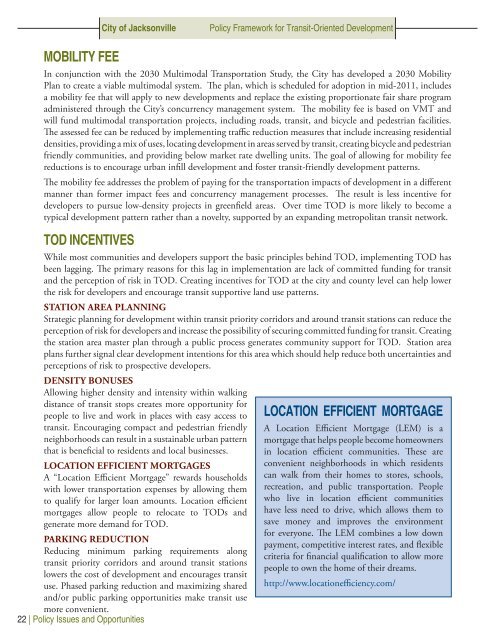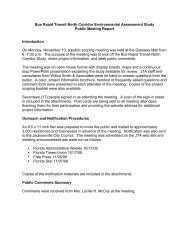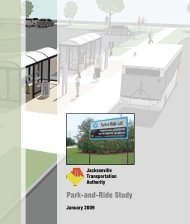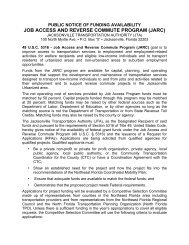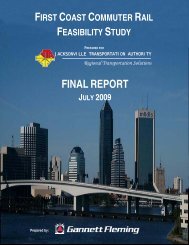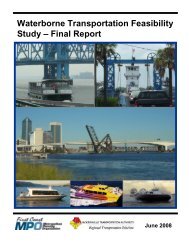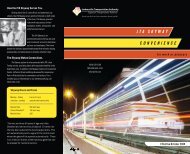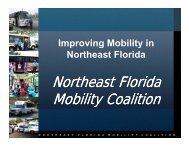Policy Framework - Jacksonville Transportation Authority
Policy Framework - Jacksonville Transportation Authority
Policy Framework - Jacksonville Transportation Authority
You also want an ePaper? Increase the reach of your titles
YUMPU automatically turns print PDFs into web optimized ePapers that Google loves.
City of <strong>Jacksonville</strong><br />
<strong>Policy</strong> <strong>Framework</strong> for Transit-Oriented Development<br />
Mobility Fee<br />
In conjunction with the 2030 Multimodal <strong>Transportation</strong> Study, the City has developed a 2030 Mobility<br />
Plan to create a viable multimodal system. The plan, which is scheduled for adoption in mid-2011, includes<br />
a mobility fee that will apply to new developments and replace the existing proportionate fair share program<br />
administered through the City’s concurrency management system. The mobility fee is based on VMT and<br />
will fund multimodal transportation projects, including roads, transit, and bicycle and pedestrian facilities.<br />
The assessed fee can be reduced by implementing traffic reduction measures that include increasing residential<br />
densities, providing a mix of uses, locating development in areas served by transit, creating bicycle and pedestrian<br />
friendly communities, and providing below market rate dwelling units. The goal of allowing for mobility fee<br />
reductions is to encourage urban infill development and foster transit-friendly development patterns.<br />
The mobility fee addresses the problem of paying for the transportation impacts of development in a different<br />
manner than former impact fees and concurrency management processes. The result is less incentive for<br />
developers to pursue low-density projects in greenfield areas. Over time TOD is more likely to become a<br />
typical development pattern rather than a novelty, supported by an expanding metropolitan transit network.<br />
TOD Incentives<br />
While most communities and developers support the basic principles behind TOD, implementing TOD has<br />
been lagging. The primary reasons for this lag in implementation are lack of committed funding for transit<br />
and the perception of risk in TOD. Creating incentives for TOD at the city and county level can help lower<br />
the risk for developers and encourage transit supportive land use patterns.<br />
Station Area Planning<br />
Strategic planning for development within transit priority corridors and around transit stations can reduce the<br />
perception of risk for developers and increase the possibility of securing committed funding for transit. Creating<br />
the station area master plan through a public process generates community support for TOD. Station area<br />
plans further signal clear development intentions for this area which should help reduce both uncertainties and<br />
perceptions of risk to prospective developers.<br />
Density Bonuses<br />
Allowing higher density and intensity within walking<br />
distance of transit stops creates more opportunity for<br />
people to live and work in places with easy access to<br />
transit. Encouraging compact and pedestrian friendly<br />
neighborhoods can result in a sustainable urban pattern<br />
that is beneficial to residents and local businesses.<br />
Location Efficient Mortgages<br />
A “Location Efficient Mortgage” rewards households<br />
with lower transportation expenses by allowing them<br />
to qualify for larger loan amounts. Location efficient<br />
mortgages allow people to relocate to TODs and<br />
generate more demand for TOD.<br />
Parking Reduction<br />
Reducing minimum parking requirements along<br />
transit priority corridors and around transit stations<br />
lowers the cost of development and encourages transit<br />
use. Phased parking reduction and maximizing shared<br />
and/or public parking opportunities make transit use<br />
more convenient.<br />
22 | <strong>Policy</strong> Issues and Opportunities<br />
LOCATION EFFICIENT MORTGAGE<br />
A Location Efficient Mortgage (LEM) is a<br />
mortgage that helps people become homeowners<br />
in location efficient communities. These are<br />
convenient neighborhoods in which residents<br />
can walk from their homes to stores, schools,<br />
recreation, and public transportation. People<br />
who live in location efficient communities<br />
have less need to drive, which allows them to<br />
save money and improves the environment<br />
for everyone. The LEM combines a low down<br />
payment, competitive interest rates, and flexible<br />
criteria for financial qualification to allow more<br />
people to own the home of their dreams.<br />
http://www.locationefficiency.com/


